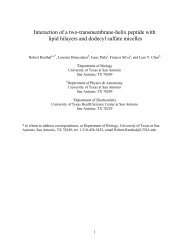Nonequilibrium fluctuation-dissipation theorem of ... - LY Chen
Nonequilibrium fluctuation-dissipation theorem of ... - LY Chen
Nonequilibrium fluctuation-dissipation theorem of ... - LY Chen
You also want an ePaper? Increase the reach of your titles
YUMPU automatically turns print PDFs into web optimized ePapers that Google loves.
144113-2 L. Y. <strong>Chen</strong> J. Chem. Phys. 129, 144113 2008<br />
Langevin equation in Eq. 3. If the Stratonovich scheme<br />
were adopted, would have a very complex dependence on<br />
the coordinates through V n+1 and F n+1 . When that complex<br />
dependence is correctly accounted for, the Stratonovich<br />
scheme should agree exactly with the Ito scheme. 9<br />
Considering the dynamics <strong>of</strong> the system is Markovian,<br />
we have the probability for transition along a given path<br />
xt=x 0 ,x 1 ,...,x N from state A x 0 =x A to state B x N<br />
=x B as follows:<br />
Px 0 ,t 0 x 1 ,t 1 ¯ x N ,t N <br />
N−1<br />
= p e x A Px n ,t n x n+1 ,t n+1 <br />
n=0<br />
= 1 N−1<br />
mxn+1 − x<br />
Np ex A exp− <br />
n + V n dt − F n dt 2<br />
,<br />
n=0 4mk B Tdt<br />
where p e x A =exp−Vx A /Z A is the equilibrium probability<br />
distribution <strong>of</strong> the system when it is constrained to the<br />
5<br />
macroscopic state A. Z A =exp−G A is the partition function<br />
and G A is the free energy <strong>of</strong> that macroscopic state.<br />
1/k B T. The system is driven from state A to state B by<br />
the external force Ft=F 0 ,F 1 ,...,F N .<br />
The following question has been asked but not answered<br />
correctly in the current literature: What is the probability for<br />
the system to take the exact reverse path x˜t<br />
=x N ,x N−1 ,...,x 0 if the external driving force is tuned backward<br />
in time, F˜ t=F N ,F N−1 ,...,F 0 Answering this<br />
question correctly requires particular attention to the subtle<br />
stochastic nature <strong>of</strong> the Brownian dynamics. Resembling exactly<br />
Eq. 4, the transition probability between state x N−n at<br />
time t n and state x N−n−1 at time t n+1 is<br />
Px N−n ,t n x N−n−1 ,t n+1 <br />
= 1 exp− mx N−n−1 − x N−n + V N−n dt − F N−n dt 2<br />
4mk B Tdt<br />
.<br />
The probability for transition along the reverse path x˜t<br />
=x N ,x N−1 ,...,x 0 is<br />
6<br />
N−1<br />
Px N ,t 0 x N−1 ,t 1 ¯ x 0 ,t N = p e x B <br />
n=0<br />
Px N−n ,t n x N−n−1 ,t n+1 = 1 N−1<br />
mxN−n−1 − x<br />
Np ex B exp− <br />
N−n + V N−n dt − F N−n dt 2<br />
,<br />
n=0<br />
4mk B Tdt<br />
where p e x B =expG B −Vx B is the equilibrium probability <strong>of</strong> the system when constrained to the macroscopic state B.<br />
The relationship between the probabilities along the forward and reverse paths will become clear once we substitute the<br />
dummy index n in the sum on the second line <strong>of</strong> Eq. 7, l=N−n−1. Then,<br />
7<br />
Px N ,t 0 x N−1 ,t 1 ¯ x 0 ,t N = 1 N−1<br />
mxl − x<br />
Np ex B exp− <br />
l+1 + V l+1 dt − F l+1 dt 2<br />
. 8<br />
l=0<br />
4mk B Tdt<br />
Note that the indices are in different order than those <strong>of</strong> Eq. 5. The ratio between the two probabilities can be found as<br />
Px 0 ,t 0 x 1 ,t 1 ¯ x N ,t N <br />
Px N ,t 0 x N−1 ,t 1 ¯ x 0 ,t N = p N−1<br />
ex A <br />
p e x B exp xn+1 − x<br />
− <br />
n V n − F n − x n − x n+1 V n+1 − F n+1 . 9<br />
2k B T<br />
n=0<br />
In deriving the above equation, we made use <strong>of</strong> the fact that<br />
dt is infinitesimal so that<br />
exp− V N − F N 2 − V 0 − F 0 2<br />
=1. 10<br />
4mk B T<br />
dtdt→0<br />
Examining the differentials in the exponent on the right hand<br />
side <strong>of</strong> Eq. 9, we note that the internal force V terms lead<br />
to the potential energy differences between states A and B as<br />
follows:<br />
N−1<br />
<br />
n=0<br />
N−1<br />
<br />
n=0<br />
N−1<br />
x n+1 − x n V n = Vx n+1 − Vx n = Vx B − Vx A ,<br />
n=0<br />
11<br />
N−1<br />
x n − x n+1 V n+1 = Vx n − Vx n+1 = Vx A − Vx B .<br />
n=0<br />
However, the external driving forces are not conservative<br />
and their terms have to be dealt with explicitly. Now we have<br />
Author complimentary copy. Redistribution subject to AIP license or copyright, see http://jcp.aip.org/jcp/copyright.jsp




